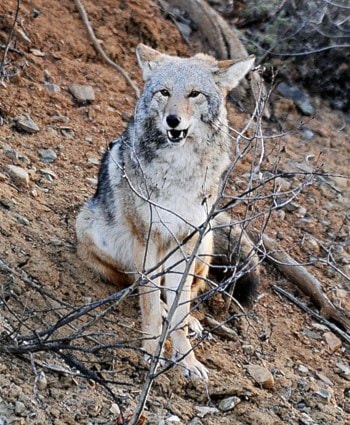A hint as to why a coyote bit a seven-year-old girl in front of the Canada Games Centre on Saturday was later discovered in the animal’s stomach.
It was a hardboiled egg - a telltale sign that the animal had been fed by people, said Mary VanderKop, the territory’s chief veterinarian.
“He was obviously used to getting people food,” she said. “They’re cute, they have fuzzy faces and they’re appealing when they’re scrounging around. And they’re pitiful because people relate to them, but (the public) doesn’t understand that when these animals lose their fear of people, it means ultimately that COs get called and wildlife get killed because they become a threat. They begin to see people as a place where they can pick up scraps, but its not much of a reach from that to testing the waters.”
People often feed animals like coyotes accidentally, when bowls of food are left out for pets. Other times, pets themselves, especially cats, can become a coyote’s dinner.
A coyote is a predator by nature, VanderKop emphasized, so it thinks: “If this human isn’t trying to eat me, maybe I could eat it.”
That makes children appealing prey. “They have high-pitched voices and they run around squeaking,” said VanderKop.
The coyote that bit the girl is believed to have harassed three boys earlier that morning. They were walking along the bike path from the Alaska Highway and Hamilton Boulevard intersection to the games centre when a coyote approached.
One boy, thinking it was a puppy, offered his hand to pet it, said Kris Gustafson, a conservation officer with the territory.
The animal snapped at the boy’s hand, missing it. The scare prompted the boys to shoo it away. But, as they carried on towards the centre, they saw the coyote was following them, said Gustafson.
It is believed to be the same coyote that, about an hour later, bit the girl outside the games centre entrance, near the flagpoles.
It rushed from behind her, biting her buttocks, said Gustafson.
Fortunately, it did not break the skin, leaving only bruising and a terrifying experience for such a young child.
The coyote didn’t continue with the attack and centre staff scared it away, watching it run across Hamilton Boulevard and into the bushes, said Art Manhire, the centre’s manager.
But the coyote came back again and began stalking people in the parking lot.
That was when the conservation officer came and shot it.
A necropsy done on the animal Monday showed no signs of a pre-existing disease nor an abnormally hungry belly - two common reasons for a male coyote to act the way it did.
The brain will be sent out for rabies testing, but that isn’t the most likely cause, said VanderKop.
While rabies has been found in foxes in the Northwest Territories and Alaska, there haven’t been any reports of the disease in the Yukon for 20 years, she said.
The coyote population in the territory is “abundant,” both Gustafson and VanderKop said.
Coyotes tend to gather around urban centres like Whitehorse, where smaller animals and human garbage is readily accessible and fewer wolves exist.
Saturday’s incident was a first for the centre, but it definitely wasn’t for the territory.
There have been about five actual attacks or bites in the past 30 years. Four were in Whitehorse, and one was on the Haines Road before the coyote was fended off with a Swiss Army knife, said Gustafson.
A few years ago, a coyote tried to attack a child who was tobogganing in Porter Creek. The coyote grabbed the child’s hood and began pulling it into the bushes.
In the Maritimes, coyote attacks are even more common and vicious. That’s believed to be fueled by breeding with wolves, said VanderKop.
Many people remember the tragic death of 19-year-old folk singer Taylor Mitchell, who in October 2009 took a break from her first music tour to hike in a national park in Cape Breton, Nova Scotia. The Toronto-born singer was attacked by two coyotes and later died in a Halifax hospital.
But no matter where you are, the take-home message remains the same, said VanderKop: do not feed wildlife.
The results from the rabies testing for the Canada Games Centre coyote should be back within about two weeks, she said.
Contact Roxanne Stasyszyn at
roxannes@yukon-news.com
